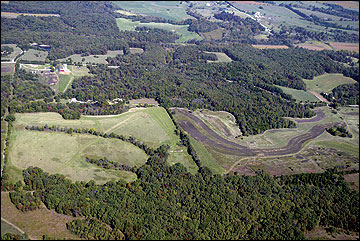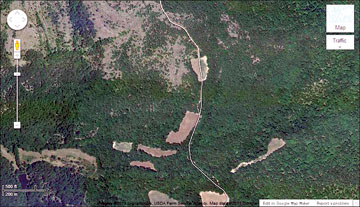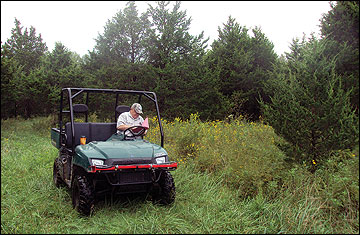White-tailed deer are one of Missouri’s most valuable resources, and many Missouri landowners, hunters and deer enthusiasts are interested in managing their properties to improve habitat conditions for them (Figure 1). White-tailed deer have adapted to a variety of habitat types in Missouri and use diverse vegetation and plant successional stages throughout the year. A mixture of forests, woodlands, grasslands, croplands and open fields provides deer with ample food, vegetative cover and water during each season (Figure 2).
Landowners can enhance habitat and the diversity of vegetation on a property, regardless of its size, by conducting a variety of management practices. Evaluating the current habitat conditions to identify deficiencies will help you determine the appropriate management practices to implement and is an important step toward successfully managing habitat for white-tailed deer.
 Figure 1. To attract deer to your property, improve the habitat by evaluating its current condition and then implementing appropriate management practices to enhance it.
Figure 1. To attract deer to your property, improve the habitat by evaluating its current condition and then implementing appropriate management practices to enhance it.
 Figure 2. Land with a diversity of habitat types — such as a mixture of forest land, cropland and open fields — provides deer with food and cover throughout the year.
Figure 2. Land with a diversity of habitat types — such as a mixture of forest land, cropland and open fields — provides deer with food and cover throughout the year.
Evaluate habitat conditions
Deer habitat is often a byproduct of land use, whether it be forest or agricultural production. However, food and cover for deer can be enhanced through various habitat management practices, such as timber harvesting, timber stand improvement practices, prescribed fire, edge feathering or managing a forest or wooded acreage for improved mast production. A habitat evaluation helps you determine the combination of management practices that will improve the area and accomplish your objectives.
When evaluating the current habitat conditions on a property, you are identifying the components in short supply — the limiting factors. This information will help you determine the management practices that need to be conducted to improve the habitat conditions and thus can guide development of your habitat management plan.
To successfully evaluate habitat, you will need an aerial photo of the property or area being managed (Figure 3) and you will need to observe the existing habitat conditions on the area (Figure 4). You can obtain aerial photos through the following websites:
- MU Center for Applied Research and Environmental Systems, https://allthingsmissouri.org/missouri-map-room
- Google Earth, http://earth.google.com/
Use your observations and the information obtained from the aerial photos to assess the overall condition of existing habitat. On the worksheet (Figure 5), identify the habitat types that exist on the property and rank their current condition.
 Figure 3. Aerial photos of your property or the areas being managed are invaluable when evaluating habitat conditions
Figure 3. Aerial photos of your property or the areas being managed are invaluable when evaluating habitat conditions
Imagery © 2013 DigitalGlobe, USDA Farm Services Agency. Map data © 2013 Google .
 Figure 4. Spending time on the property observing habitat conditions is an important part of a habitat evaluation.
Figure 4. Spending time on the property observing habitat conditions is an important part of a habitat evaluation.
Figure 5. Evaluate the white-tailed deer management area based on the habitat criteria described on this worksheet. For more information, refer to other MU Extension publications on enhancing white-tailed deer habitats on your property.
Address the limiting factors
After evaluating the area, design a habitat management plan that initially focuses on addressing the habitat components or factors that are in shortest supply. Below are two examples of how you can use the evaluation results to identify potential deficiencies on an area.
If the property consists primarily of woodland or forest, consider these questions:
- Does the area have enough openings that provide the early successional vegetation ideal for deer?
- Does the woodland contain a diversity of mast-producing oaks and a variety of trees and shrubs in various stages of succession?
- Does the area contain thick, brushy cover?
If the area consists primarily of pastures and cropland, consider these questions:
- Are adequate amounts of acreage nearby that can provide cover and hard mast?
- Are trees and shrubs needed to address this limiting factor?
Considering these types of questions will help you determine the appropriate combination of management practices that will address the property’s limiting factors.
Although many Missouri landowners do not own or control large enough properties to effectively manage a deer herd, they can manage their smaller acreages to provide quality habitat. Where landownership patterns consist of many small parcels, deer management can also be effective when neighbors work together toward similar management goals. Managing a large area provides additional opportunities to incorporate beneficial deer habitat management practices on a larger scale and to better manage the deer herd.
Conclusion
Developing a habitat management plan is an important step in improving the conditions for white-tailed deer and other wildlife. Before you can develop an effective plan, you need to know the current habitat conditions within the area being managed. Although white-tailed deer have adapted to live and thrive in a variety of habitat types across Missouri, certain conditions make an area more appealing to them. By evaluating the current condition of the habitat, you can identify the property’s deficiencies and determine appropriate management practices to implement over time to improve deer habitat on the area.
Habitat can be evaluated in several ways. This guide describes a basic method landowners can use to assess the quality of deer habitat on an area. Contact a private land conservationist with the Missouri Department of Conservation (http://mdc.mo.gov/contact-us) or MU Extension (https://extension.missouri.edu/locations) for more specific information or assistance in evaluating habitat and developing a white-tailed deer management plan for your property.